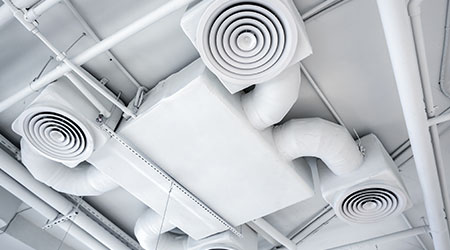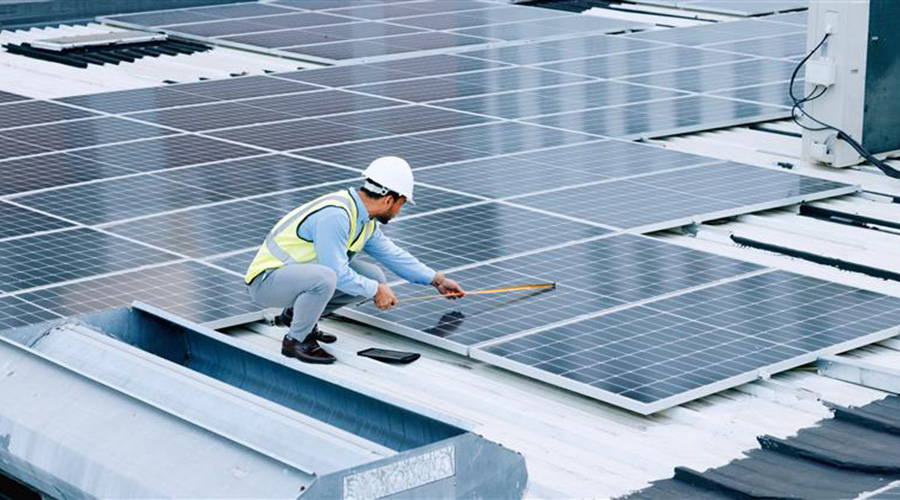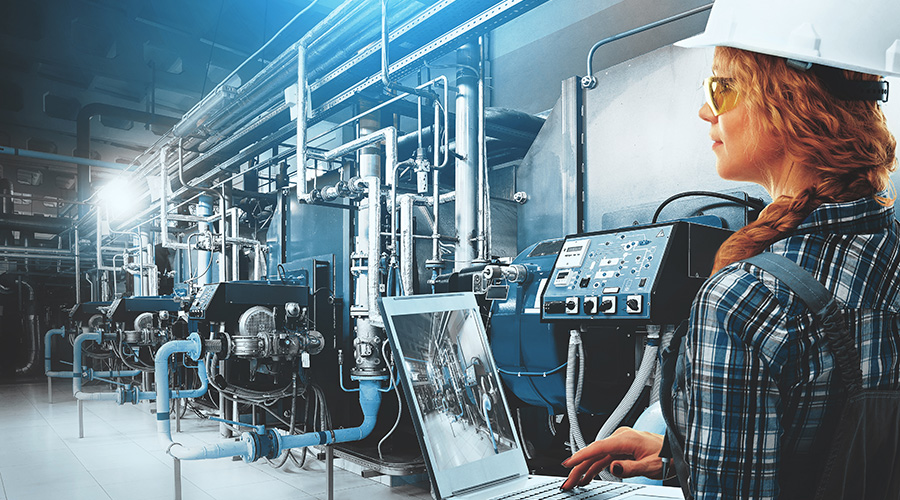 Realizing the situation in facilities has changed, ASHRAE offered managers suggested actions to improve IAQ and limit possible transmission of the coronavirus.
Realizing the situation in facilities has changed, ASHRAE offered managers suggested actions to improve IAQ and limit possible transmission of the coronavirus.Filtration and Ventilation Strategies for the COVID-19 Era
Facility managers are re-examining their facilities’ strategies with focus on limiting the negative impact of airborne particles on building occupants.
The need for improved indoor air quality (IAQ) has been an increasing concern for maintenance and engineering managers. As a result, many are re-examining their facilities’ ventilation and filtration strategies with a focus on limiting the negative impact of airborne particles on building occupants, particles that include the coronavirus.
These strategies typically include changes to the facility’s HVAC filtration system, installation of supplemental filtration systems, increasing system ventilation rates, or all three. Advances in filtration systems and ventilation standards give managers options. Which system is most appropriate for a particular facility depends on the requirements of the application.
Static filtration focus
Most building filtration systems consist of static filtration systems — filters whose particle removal mechanism consists of straining, impaction, or sieving. Typical filters are constructed from spun fiberglass, polyester, pleated paper, or cloth. They are inexpensive, and most are disposable. Their effectiveness in removing particles from the airstream is measured by their MERV number. The higher the number, the greater the filter’s efficiency.
The most efficient static filtration filter is the high-efficiency particulate air (HEPA) filter. With a MERV rating of 16, HEPA filters are able to remove 99.9 percent of particles in the airstream of 0.3 microns or larger. Not all HVAC systems can use HEPA filters due to the large pressure drop that they impose across the filter.
Static filtration systems have been used successfully in HVAC systems for decades, but they have limitations. While they can remove the larger particles from the airstream, most are ineffective against pathogens.
A new generation of static filters uses nanofibers. A nanofiber has a diameter of less than 100 nanometers, or roughly one-tenth the diameter of the fibers found in conventional static filters. Constructed from polymers, the nanofibers form a fine mesh similar to a spider web. The spaces between the nanofibers consist of fine pores that are very efficient at capturing airborne particles, including allergens, mold spores, and mites. Most have a MERV rating between 11 and 13.
Nanofiber filters cost more than conventional static filters, but they offer several advantages. For the same filtering efficiency, nanofiber filters have a lower pressure drop than conventional filters, meaning lower fan energy requirements for the same airflow rate in the system.
The efficiency of a nanofiber filter is relatively constant over its service life. In contrast, when a new conventional static filter is installed, its efficiency is lower than one that has been in service. As the filter loads up with captured particles, its filtering efficiency increases. Nanofiber filters operate at the same efficiency when they are new as when they have been in service for some time.
Eye on electrostatic
An electrostatic air filter is a two-stage unit that uses static electricity to remove particles from the airstream. The first, or charging, stage consists of ionizer wires connected to a high- voltage power supply that imparts a positive electrostatic charge on particles as they pass through the ionizing field. The second, or collector, stage consists of oppositely charged metal plates. Particles charged in the first stage are attracted to and become attached to these plates, which are periodically removed and cleaned. Typical MERV ratings are in the range of four to six.
Electrostatic air filters offer several advantages. Because they are an open-cell design, they have a low pressure drop, reducing fan energy use. While the filters are more expensive than static filters, they are washable, reducing long-term costs.
One of the biggest drawbacks of an electrostatic air filter is its relatively low MERV rating compared to other filtration systems. Another drawback is that its use of an ionizing field to charge particles can produce ozone, which can be harmful to health, even in small quantities.
Dynamic air filters represent a newer generation of electrostatic filters. A hybrid of electrostatic and static air filters, dynamic air filters avoid the problems of ozone generation by using a low-current, low-voltage power source that applies power directly to a grid embedded within the filter. The grid polarizes the filter’s fibers, causing them to attract and hold particles in the airstream. Once attached to the filters, the particles attract and bond to other particles. Particles that are too small to be collected become polarized and adhere to other particles and can then be held by the filter.
Like conventional electrostatic filters, dynamic air filters offer low pressure drop. Their MERV rating can be as high as 13 while producing no ozone. The filters can also remove some odors and volatile organic compounds.
Ultraviolet light systems
More than 150 years ago, researchers found that ultraviolet (UV) light was an effective way to disinfect surfaces. Healthcare facilities and water purification systems have made wide use of UV-based systems, and managers have specified them for building HVAC systems to keep cooling coils free of biological growth.
UV light is effective against viruses because it damages a virus’s DNA and RNA, making it inactive. While UV light wavelengths range from 10 to 400 nanometers (nm), it has been shown that UV-C with a wavelength of 200-280 nm is the most effective at destroying viruses. With enough intensity and a long enough exposure, UV-C can destroy up to 99 percent of exposed viruses.
While minimizing biological growth on coils has been the primary application for using UV-C in HVAC systems, the pandemic has focused attention on using UV-C light to destroy the virus within the HVAC system’s airstream. UV-C fixtures can be installed in HVAC system ductwork — typically, close to the coil — so they can expose pathogens in the airstream and any that might have grown on the coil. Because their effectiveness in destroying pathogens is directly related to the exposure intensity and duration, managers should plan the installation carefully.
UV-C light is harmful to eyes and skin and can cause permanent damage, so it is essential that installers provide protection for maintenance personnel. This means providing automatic shutoff switches on all access panels near the lamps, installing UV light-blocking filters on all inspection windows, and training personnel who might be working on the HVAC system in the vicinity of the lamps.
UV-C in-duct systems offer several advantages. Their installation and operating costs are low. They can destroy pathogens within the system. They also are effective in preventing a buildup of biological material on system coils, improving IAQ and system performance.
Portable filters
The design and configuration of HVAC systems often does not allow for the changes needed to sufficiently improve IAQ without major modifications. Similarly, some areas in a facility might have stricter IAQ requirements than the central system can meet. For these applications, managers can consider a number of new-generation portable air filtration systems.
Portable air filtration systems are standalone units that technicians can move to areas where and when they are needed. System sizes range from desktop units to those that can serve a large room. Technicians can configure them with different filtering systems, including high MERV value static filters, HEPA filters, UV light systems, and activated charcoal filters.
Portable air filters give managers unlimited flexibility in meeting the needs of specific areas in their facilities. Since they operate independently of a building’s central HVAC system, they can continue to clean the air even when the central HVAC system is not operating. And they are portable, increasing their potential usefulness.
Ventilation rates
Over the past several decades, the HVAC system design standard has been to have systems operate with a minimum amount of outdoor fresh air, a tactic that saves heating and cooling energy. But reduced outdoor air levels come at a price. Lower outdoor air levels result in less dilution of contaminants in the air circulated by the system. The pandemic has forced managers to re-examine this position.
ASHRAE Standard 62.1-2019 specifies the minimum ventilation rate, air cleaning system design, installation, commissioning, operating, and maintenance for new and existing buildings to provide acceptable IAQ. Managers need to remember that these are recommended minimum ventilation rates, not target rates.
Realizing that things have changed, ASHRAE released “Guidance for Building Operations During COVID-19 Pandemic” in May 2020. The publication offers a number of suggested steps managers can take to improve IAQ and limit possible transmission of the virus, including these:
- Install the highest MERV rated filters compatible with the HVAC system.
- Run HVAC systems longer hours to enhance the filtering process.
- Use portable air cleaners with HEPA filters.
- Use UV-C irradiation in high-risk areas.
Not all filtration systems work effectively in all buildings, since HVAC systems might not be able to support them. But if managers understand the type and level of contamination present in their building and the level of cleanliness needed, they can select the filtration system most appropriate for their application.
Related Topics:













